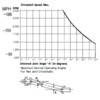I recently replaced my coil-overs with adjustable units, so that I could set my ride height where I'd like.
I ended up dropping the front of the car 1/2", and the rear by 1".
A couple of subsequent test rides showed a significant driveline vibration, especially pronounced when hard on the throttle in a lower gear.
I inspected the half-shafts, all U-joints are tight and the shafts are 'in-phase'.
The U-joint angles do look a bit extreme at this lowered ride height, so I measured them with my magnetic angle finder.
The angle at the ZF end of the shaft is around 7.5 degrees or so.
I think I remember an earlier George P. post stating the U-joins want to be less than 3 degrees or so.
So....is a CV joint conversion my only option at this point?
Anything else for me to inspect?
No, I'm not going back to the stock ride height...


